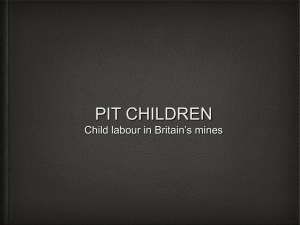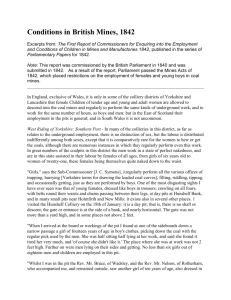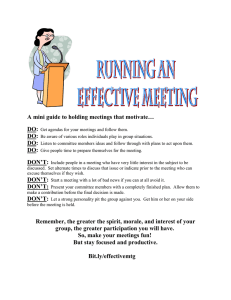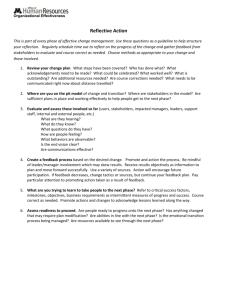C L M H I L D
advertisement
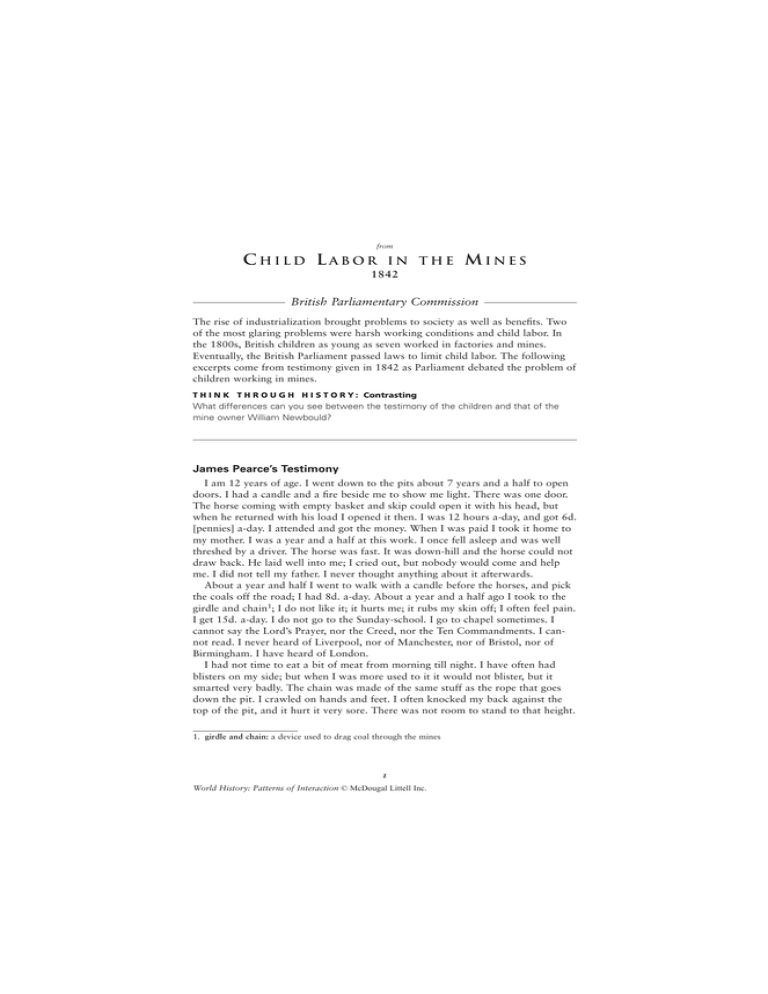
from CHILD LABOR IN THE MINES 1842 British Parliamentary Commission The rise of industrialization brought problems to society as well as benefits. Two of the most glaring problems were harsh working conditions and child labor. In the 1800s, British children as young as seven worked in factories and mines. Eventually, the British Parliament passed laws to limit child labor. The following excerpts come from testimony given in 1842 as Parliament debated the problem of children working in mines. T H I N K T H R O U G H H I S T O R Y : Contrasting What differences can you see between the testimony of the children and that of the mine owner William Newbould? James Pearce’s Testimony I am 12 years of age. I went down to the pits about 7 years and a half to open doors. I had a candle and a fire beside me to show me light. There was one door. The horse coming with empty basket and skip could open it with his head, but when he returned with his load I opened it then. I was 12 hours a-day, and got 6d. [pennies] a-day. I attended and got the money. When I was paid I took it home to my mother. I was a year and a half at this work. I once fell asleep and was well threshed by a driver. The horse was fast. It was down-hill and the horse could not draw back. He laid well into me; I cried out, but nobody would come and help me. I did not tell my father. I never thought anything about it afterwards. About a year and half I went to walk with a candle before the horses, and pick the coals off the road; I had 8d. a-day. About a year and a half ago I took to the girdle and chain1; I do not like it; it hurts me; it rubs my skin off; I often feel pain. I get 15d. a-day. I do not go to the Sunday-school. I go to chapel sometimes. I cannot say the Lord’s Prayer, nor the Creed, nor the Ten Commandments. I cannot read. I never heard of Liverpool, nor of Manchester, nor of Bristol, nor of Birmingham. I have heard of London. I had not time to eat a bit of meat from morning till night. I have often had blisters on my side; but when I was more used to it it would not blister, but it smarted very badly. The chain was made of the same stuff as the rope that goes down the pit. I crawled on hands and feet. I often knocked my back against the top of the pit, and it hurt it very sore. There was not room to stand to that height. 1. girdle and chain: a device used to drag coal through the mines 1 World History: Patterns of Interaction © McDougal Littell Inc. from Child Labor in the Mines The legs ached very badly. When I came home at night I often sat down to rest me by the way I was so tired. The work made me look much older than I was. I worked at this drawing with girdle and chain 3 or 4 months. I thought that if I kept at this work I should be nothing at all, and I went and worked upon the bank. I had 1s. [shilling] 6d. when I first went to draw, and had at last 2s.4d. I went to drive two horses on the bank, and got 12s. a-week. I was three quarters of a year at this. I then took to the pit. I filled the skips for the boys to draw. A boy must go 4 or 5 times to bring a horse-load. I got 3s. a-day. Edward Potter’s Testimony I am a coal viewer, and the manager of the South Hetton colliery.2 We have about 400 bound people [contract laborers], and in addition our bank people [foremen], men and boys about 700. In the pits 427 men and boys; of these, 290 men, hewers and stonemen. The stonemen or shifters dig stone in the mine, make horse-ways and air-ways. On the banks are smiths, joiners, and other workmen. Of the children in the pits we have none under eight, and only three so young. We are constantly beset by parents coming making application to take children under the age, and they are very anxious and very dissatisfied if we do not take the children; and there have been cases in times of brisk trade, when the parents have threatened to leave the colliery, and go elsewhere if we did not comply. At every successive binding, which takes place yearly, constant attempts are made to get the boys engaged to work to which they are not competent from their years. In point of fact, we would rather not have boys until nine years of age complete. If younger than that, they are apt to fall asleep and get hurt: some get killed. It is no interest to the company to take any boys under nine. We have no females, and I do not believe there is a case of females being employed in the collieries either of Durham or Northumberland. We have no apprentices to any under ground work as colliers, nor as far as I know is there any in either county. Testimony of Wm. Newbould, Esq., Owner of Intake Colliery That children go into his pits to work at nine years of age, and their employment at that age is trapping, at 12, or thereabouts, they drive the horses. They begin to assist in hurrying at about 14, and to fill also at the same age; they begin to get [to dig coal] generally at 19; they are at that age allowed to be their own masters. A large boy or a man and a small boy go to hurry together. The men themselves employ the hurryers. Is sure there is no ill-usage of the boys, and does not allow them to be beaten. If there are any complaints, they are brought before him. The morals of the young persons and children are neither bad nor good. They have no very dissipated characters among them. There are not any really drunken men about the place—deponent3 won’t have them. Deponent pays for 12 children (most of them girls) to be educated. The boys who go to work in the pit cannot go to day-schools, but most of them go to 2. colliery: a coal mine and its outbuildings 3. deponent: the person giving testimony; William Newbould is referring to himself 2 World History: Patterns of Interaction © McDougal Littell Inc. from Child Labor in the Mines Sunday schools. They can nearly all read, and they could learn in the evenings if they chose; they are not too tired with their work to do so. The boys work twelve hours a-day, off and on, but it is not hard work, and they do not actually work the whole time. Thinks that the limitation of child labour is not needful as far as his own pits are concerned, but cannot speak about others. Thinks relays of children would be inconvenient. The parents would not send them to school unless forced. They (the parents) can scarcely find means for educating them as it is. Being in the pit keeps the children out of mischief, and they are always in the dry, and their health is good, better than that of those who are running about in all weathers. They like being in the pit themselves. The proprietor pays the getters who have piece wages, and who hire and pay the hurriers and the fillers; he also hires the trappers and horse-drivers, and has sufficient control over all parties to prevent the ill-usage of any. Testimony of Hannah Richardson, 39 years of age I’ve one child that works in the pit; he’s going on ten. He is down from 6 to 8; he is a trapper; he’s not much tired with the work, it’s only the confinement that tires him. He likes it pretty well, for he’d rather be in the pit than go to school. There is not much difference in his health since he went into the pit. He was at school before, and can read pretty well, but can’t write. He is used pretty well; I never hear him complain. I’ve another son in the pit, 17 years old; he’s a hurrier and filler. He went into the pit at eight years old. It’s not hurt his health nor his appetite, for he’s a good size. It would hurt us if children were prevented from working till 11 or 12 years old, because we’ve not jobs enow to live now as it is. Testimony of Wm. Drury, nearly 10 years old It’s half a year yesterday since I first went into the pit. I trapped at first, but not long. I have to hurry now, with another boy; we hurry both full and empty corves; it’s hard work when we’ve up hill to hurry, and there’s a good deal of up hill. I am tired when I have to work late. There is one fills, and we two have to hurry during the day; we’ve no time to stop. I’d rather be in the pit than at school; I like being in the pit. Sometimes they thump us; when they call us and we call them again, they clout us. The fillers tell us to call them. Sometimes the fillers clout us and hurt us a good deal; sometimes they put candles in our mouths, or make us drink oil when they want to swap with us for us to fill and them to hurry, and we won’t. I go into the pit at five in the morning and come out at six at night, sometimes at five; I then get my drinking and go to bed; I’ve plenty to eat; I can’t read nor write; I haven’t been much to school, only on Sundays; I go to church; I don’t know who Jesus Christ was, I’ve never been told; I don’t know where I shall go to when I die if I’m a bad boy. I’ve not been taught that. Source: Excerpt from First Report of Commissioners for Inquiring Into the Employment and Condition of Children in Mines and Manufactories (London: Her Britannic Majesty’s Stationery Office, 1842), Volume 16, pp. 83–85, 149–150, 153–154, 228–230, 251. 3 World History: Patterns of Interaction © McDougal Littell Inc. from Child Labor in the Mines T H I N K T H R O U G H H I S T O R Y : ANSWER Newbould stated that the boys were not treated badly and did not do hard work. He also claimed that most of them could read and that mining kept them out of mischief. However, the children’s testimony described the hard work in the mines, the beatings by adults, and the lack of education. 4 World History: Patterns of Interaction © McDougal Littell Inc.
